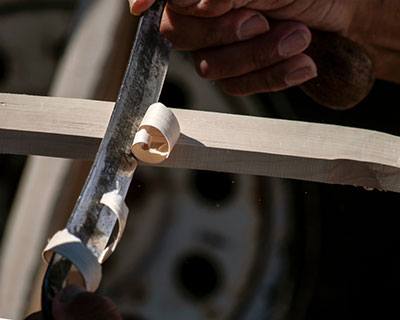Making a lacrosse stick from scratch might seem challenging for any lacrosse player.
Don't be intimidated, though. The necessary materials and steps to construct your homemade wooden lacrosse stick are surprisingly easy! In this blog post, we will walk you through all the necessary details you need to know if you want to make a sturdy and playable traditional style or modern-day stringing pattern in the comfort of your home.
Read on as we discuss different types of wood, textile supplies, strings & mesh components – plus much more – so you can create an iconic piece of functional sporting equipment right at hand.
Let's start learning how to make a homemade lacrosse stick with everything at your disposal in 2023! The process might be long, but the result is worth it!
More...
Take Away Key Points:
What are the parts of a lacrosse stick?
A lacrosse shaft is an essential piece of equipment for any player. It consists of four main parts: the head, shaft, pocket, and stringing.
1. The head: The top part of the stick that sits on the shaft is the head. This contains a rounded plastic scoop used to pick up and cradle the ball. It also acts as a channel for the ball to be passed or shot for it to reach its target.
2. The shaft: The shaft is made from either aluminum or composite material and provides control when passing or shooting. The length can vary depending on age and level of play; however, most regulations state that adult players must use a 40-inch long stick.
3. The pocket: The pocket is a pouch made from leather and nylon, which holds the ball between the head and shaft when catching, cradling, or throwing. Many different varieties are available with pockets ranging from traditional leather mesh to modern 'fully-loaded' softer mesh pockets, allowing improved accuracy when shooting or passing.
4. The stringing: This refers to the network of strings that connect the pocket to the head and shaft, allowing it to hold its shape while enabling manufacturers to customize shapes according to individual requirements.
How to make your own lacrosse stick?
Making your game lacrosse sticks is a great way to save money and get the perfect fit for you. Here's what you need to know:
Step 1: Choose the type of wood

There are many types of wooden lacrosse sticks and materials suitable for making sticks, but the most popular options include ash, birch, hickory, and maple.
- Ash: Ash is lighter yet strong, creating a durable stick with good response. It is also known for its shock-absorbent properties, which add an extra layer of light protection to your hands when catching or shooting the ball.
- Birch: This type of wood is known for its strength and flexibility. It's often preferred by experienced players who want a stiffer feel when shooting or passing.
- Hickory: Hickory is hardwood with excellent shock absorption and durability. Its strength makes it a popular choice among new players just starting in the sport and still practicing their angles and shooting skills.
- Maple: Maple is another durable and secure hardwood that offers great impact resistance and power transfer when hitting the ball. It's usually only used by experienced lacrosse players due to its heavier weight compared to other types of wood.
Step 2: Decide on the length
Choosing the length of your game lacrosse sticks depends on a few factors, including size and preference.
Consider the circumference and length of your shaft before buying a pre-made head for accurate measurement. The standard measurements usually consists of the head, so measure the head separately and make any necessary adjustments. Subtract the length corresponding to the slot at the end of the head from your calculation to get an accurate size.
Take note of the connecting portion of the head to determine which thickness should be chosen for your stick. If you have a standard head, then it should automatically fall under legal regulations about shafts.
Lastly, there is no need to cut down into octagonal shapes unless you are used to using a cut saw, as that requires precise side cuts to obtain a good grip on your stick.
Step 3: Start cutting!
Before cutting down your homemade lacrosse sticks to the desired length, grab all the necessary tools and a friend who can safely operate them. A planer should be used to ensure that the wood board is of equal thickness throughout – this should measure approximately 1 inch in thickness.
Then, use a table saw to cut the board's width to 1 inch. Note that when you are finished cutting, the dimensions should be marked as 1" x 1" x 72".
Once you have chosen an edge for the hoop to go on, further trim the wood down to about ¼ inch thick for 14 inches of length and then taper it back out to its original thickness. To complete the tongue shape, sand its edge and round off any corners at their ends. Finally, a tool like a dremel can be used to create notches at its end to secure the hoop later on.
Step 4: Final touches
Sand down all rough edges using sandpaper for smoothness. Next, drill a hole in each piece so that they can be connected with string later on (you can find kits with pre-measured strings).
Finally, attach your pocket or mesh to the head of your stick using epoxy glue designed for lacrosse sticks. If you prefer, you can further paint the stick or stain it and adjust it to your liking.
Allow enough time for the process to dry overnight before playing with it, and add the rest of the netting!
FAQs
What makes a lacrosse stick legal?

For a lacrosse shaft to be considered legal, it must meet specific standards set by the current governing body of the sports games.
Ideally, this includes specific requirements, such as a pocket depth not exceeding four inches and a shaft length not exceeding six feet.
The materials used in construction also need to comply with specific guidelines – typically, wooden lacrosse sticks should use ash or hickory, while metal lacrosse sticks must adhere to NCAA specifications. Additionally, if strung according to regulations, the head of the stick should be able to maintain its shape when holding the ball without using a lot of extra force.
How long does it take to make a wooden lacrosse stick?
On average, it usually takes about two hours to make a wooden lacrosse stick from scratch.
This time frame may vary depending on the type of wood, tools being used, and the individual's play experience in putting it together.
Essential steps include cutting down and sanding the wood, stringing the head, and finally shaping it into its final form. To ensure a professional result, due care should also be taken at each process step.
How to make a Native American lacrosse stick?
Making a Native American lacrosse stick typically involves sourcing suitable wood, such as hickory or red oak, cutting it down to size, carving out the head and handle, and drilling holes for stringing, sanding, and shaping the final product.
Once finished, the stick should be decorated with traditional Native American motifs and colors. To ensure the authenticity of your work, you may want to consult with tribal elders who have expertise in these crafts.
How to make a mini lacrosse stick?
Making a mini lacrosse stick usually involves sourcing suitable materials such as wood, PVC pipe, or bamboo, cutting it down to the desired size, and drilling a hole for stringing and attaching a head. The final step is sanding and shaping the stick.
Decorations such as stickers can be added to personalize the finished product. Depending on the materials used and the individual's crafting abilities, it may take anywhere from one to three hours to make a mini lacrosse stick from scratch.
How do you screw in a lacrosse head?
To screw in a lacrosse head, start by ensuring the head's jaw faces up. Next, use a wrench to loosen the screws and carefully remove them from the head. Next, insert the shaft into the appropriate slot on the head and thread two screws through each of them. Finally, securely tighten them with a screwdriver or wrench, and you should be ready.
How do you make a lacrosse head fit a shaft?
To make a lacrosse head fit a shaft, start by ensuring the head is the right size for the shaft.
Measure both the shaft and head to determine if one needs to be adjusted before proceeding. If needed, sand down any rough edges of the shaft using sandpaper and cut off any extra length with a saw. Once this is done, attach the head by slipping it over the end of the shaft.
Securely tighten screws on each side of the head using a screwdriver or wrench. Make sure not to over-tighten, as this could damage your lacrosse stick.
Conclusion
With the right supplies and patience, anyone can make their custom lacrosse stick. It's a great way to get creative and show your style on the field.
Taking the time to make your stick means that you will have a one-of-a-kind design that no one else has. Plus, it'll save you money in the long run, so it's well worth taking the time to make your own!
